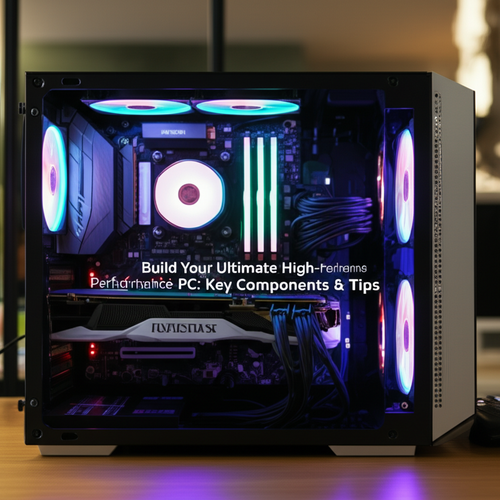Building Your High-Performance PC: Essentials for Modern Demands
In today’s fast-paced digital world, a robust and reliable computer isn’t just a luxury; it’s a necessity for many. Whether you’re a hardcore gamer, a professional content creator, or someone who demands seamless multitasking, a high-performance PC is key to unlocking your full potential. This guide will walk you through the essential components and considerations for building a machine that not only meets but exceeds modern demands, offering a blend of power, efficiency, and future-proofing.
Building a custom high-performance PC allows for tailored specifications that off-the-shelf models often can’t match. It provides the flexibility to choose premium components, optimize for specific workloads, and ensure longevity through strategic upgrades. Let’s delve into what makes a truly powerful system.
Core Components of a High-Performance PC
Every powerful computer is a symphony of meticulously chosen parts working in harmony. Understanding each component’s role is crucial for making informed decisions.
The Processor (CPU): Your System’s Brain
The Central Processing Unit (CPU) is the brain of your computer, responsible for executing instructions and processing data. For a high-performance PC, you’ll want a CPU with a high core count and fast clock speeds. Both Intel and AMD offer excellent options, with performance varying across different price points and generations. Consider your primary use case; heavy multitasking and complex computations benefit greatly from more cores.
Graphics Card (GPU): Visual Powerhouse
For gaming, video editing, 3D rendering, and any task involving visual processing, the Graphics Processing Unit (GPU) is paramount. A powerful GPU delivers smooth frame rates, accelerates rendering times, and handles complex graphical computations with ease. NVIDIA and AMD are the leading manufacturers, each with a range of cards suited for different budgets and performance tiers. For demanding applications like cryptocurrency mining or high-end simulations, GPUs are often the bottleneck, making this a critical component choice.
RAM: Multitasking Made Easy
Random Access Memory (RAM) is where your computer stores data that it needs to access quickly. For a high-performance PC, 16GB is typically the minimum for a smooth experience, with 32GB or even 64GB recommended for heavy content creation, professional applications, or intense multitasking. Look for higher clock speeds (e.g., 3200MHz, 3600MHz) and lower latencies for optimal performance, especially with AMD Ryzen processors.
Storage: Speed and Capacity
Fast storage is fundamental to a responsive system. NVMe Solid State Drives (SSDs) connected via PCIe offer significantly faster read and write speeds compared to traditional SATA SSDs, drastically reducing boot times and application loading. For your operating system and frequently used programs, an NVMe SSD is a must. For larger game libraries or media files, a secondary, high-capacity SATA SSD or even a traditional Hard Disk Drive (HDD) can provide ample storage at a lower cost per gigabyte.
Motherboard: The Foundation
The motherboard connects all your components, facilitating communication between them. It needs to be compatible with your chosen CPU socket (e.g., AM4, LGA1700) and support your RAM type (DDR4, DDR5) and speed. Key features to look for include sufficient PCIe slots for your GPU and NVMe drives, robust power delivery for stable overclocking (if desired), and modern connectivity like USB 3.2 and Wi-Fi 6/6E. A good motherboard ensures expandability and stability for your high-performance build.
Power Supply Unit (PSU): Reliable Energy
The Power Supply Unit (PSU) delivers electricity to all your components. It’s crucial not to skimp on this part. A high-quality PSU ensures stable power delivery, protecting your components and contributing to system longevity. Calculate your estimated wattage requirements based on your CPU, GPU, and other components, then add a buffer. Aim for a PSU with an 80 PLUS Bronze, Gold, or Platinum certification for better efficiency, which translates to less wasted heat and lower electricity bills.
Cooling Solutions: Keeping Temperatures Low
High-performance components generate significant heat, and effective cooling is essential for maintaining optimal performance and preventing thermal throttling. You can choose between air coolers and liquid coolers (AIOs or custom loops). Air coolers are often simpler and more affordable, while liquid coolers generally offer superior performance and aesthetics. Ensure your chosen cooler is compatible with your CPU socket and fits within your PC case. For comprehensive guidance on selecting and integrating various PC components, experts at PCPRAHA can provide invaluable insights.
Planning Your Build: Beyond the Specs
Building a high-performance PC involves more than just picking powerful parts; it requires strategic planning to meet your specific needs and budget.
Defining Your Use Case
Before selecting components, clearly define your PC’s primary purpose. Are you building a top-tier gaming rig for competitive esports and AAA titles? Do you need a workstation for video editing, 3D rendering, or complex data analysis? Are you venturing into specialized fields like AI/ML development or even Minerboxes.com-level cryptocurrency operations? Your answers will dictate where to allocate your budget and which components to prioritize. For instance, a gaming PC emphasizes GPU power, while a workstation might prioritize CPU cores and RAM.
Budgeting Wisely
Set a realistic budget and stick to it. While it’s tempting to get the absolute best of everything, thoughtful allocation can save you money without significant performance loss. Identify which components are most critical for your primary use case and invest heavily there. For example, if you’re a gamer, a high-end GPU is often a better investment than the absolute top-tier CPU if you have to compromise elsewhere. Researching current market prices and potential sales can also help maximize your budget.
Component Compatibility and Sourcing
Ensure all your chosen components are compatible. The CPU must fit the motherboard socket, RAM must be the correct type (DDR4/DDR5) and compatible with the motherboard, and your case must accommodate your motherboard size and GPU length. Utilize online PC builder tools that check compatibility automatically. When purchasing, opt for reputable retailers to ensure genuine products, warranties, and reliable customer service. Supply chain issues can sometimes impact component availability and pricing, making it wise to stay informed on market trends.
Assembling Your PC: Key Steps and Tips
Once you have all your components, the real fun begins. Assembly can seem daunting, but by following a logical sequence, it becomes a rewarding experience.
Preparation and Safety
Work on a clean, well-lit, non-carpeted surface to minimize static electricity. Ground yourself regularly by touching a metal part of the PC case to discharge any static. Have your tools ready: a Phillips head screwdriver, zip ties for cable management, and potentially a magnetic parts tray for screws.
Installation Order
A common and efficient installation order is: CPU onto the motherboard, then CPU cooler (if not pre-mounted), then RAM. Install the motherboard into the case, followed by the GPU, storage drives, and finally, connect the power supply. This sequence minimizes obstruction and simplifies cable routing.
Cable Management
Good cable management isn’t just for aesthetics; it improves airflow, which is crucial for cooling. Utilize the cable routing holes and tie-down points in your PC case. Take your time to route cables neatly behind the motherboard tray. This step, while often overlooked, significantly contributes to the overall longevity and performance of your high-performance PC.
First Boot and Software Setup
After assembly, connect your monitor, keyboard, and mouse. Power on your PC and enter the BIOS/UEFI to verify all components are recognized. Then, install your operating system (Windows, Linux) from a USB drive. Once the OS is installed, download and install the latest drivers for your motherboard, GPU, and other peripherals. Keeping your drivers up-to-date is vital for optimal performance and stability.
Future-Proofing Your High-Performance PC
Investing in a high-performance PC means considering its longevity and adaptability to emerging technologies.
Upgradeability Considerations
Design your build with future upgrades in mind. Choose a motherboard that supports the next generation of CPUs if possible, and ensure your PSU has enough headroom for a more powerful GPU down the line. Cases with good airflow and ample space make future component swaps much easier. Opting for a modular PSU also simplifies upgrades and maintenance.
Embracing New Technologies
The tech landscape is constantly evolving, with advancements in AI, machine learning, and advanced rendering techniques pushing hardware limits. Staying informed about industry trends, often reported by major news outlets like Reuters, can help you make informed decisions about when and what to upgrade. Modern GPUs, for example, are increasingly optimized for AI workloads, making them versatile tools beyond traditional gaming.
Performance Optimization
Regular maintenance is crucial for keeping your high-performance PC running smoothly. This includes keeping drivers updated, cleaning out dust from fans and heatsinks, and monitoring component temperatures. Software optimizations, such as defragmenting HDDs (if used), managing startup programs, and running antivirus scans, also contribute to sustained peak performance.
Conclusion
Building a high-performance PC is a rewarding endeavor that empowers you with a machine tailored to your exact specifications. By carefully selecting each component, meticulously planning your build, and adopting a mindset of continuous optimization, you can create a system that delivers unparalleled performance for years to come. Whether you’re conquering virtual worlds, creating stunning digital art, or pushing the boundaries of scientific computing, your custom-built PC will be your ultimate tool.



